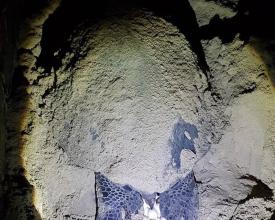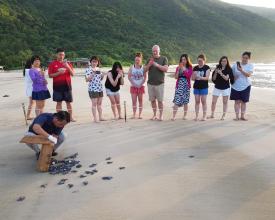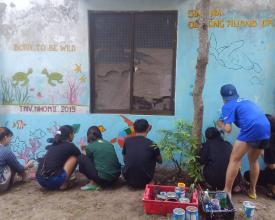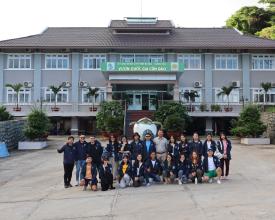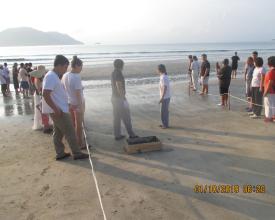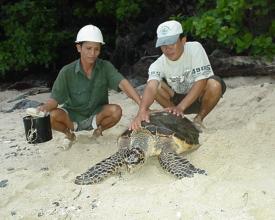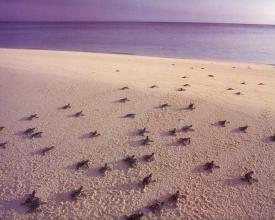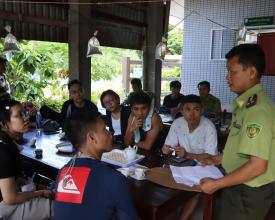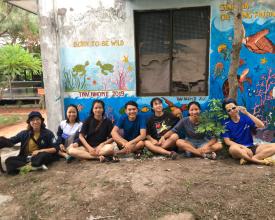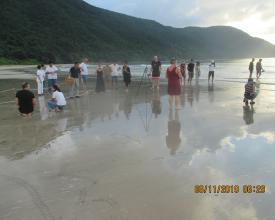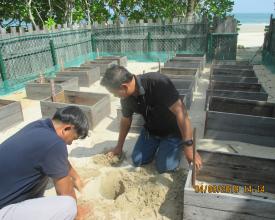
Sea turtle conservation programme in Con Dao National Park, Vietnam
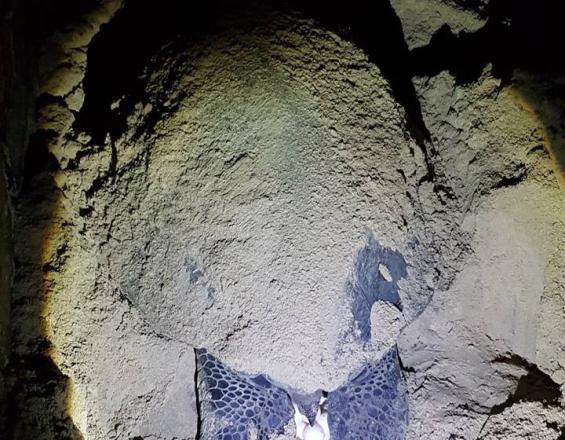
The sea turtle conservation activities started since the establishment of Con Dao Forbidden Forest in 1984. After the site was upgraded to a national park in 1993, with support from international organizations, the park has implemented a sea turtle conservation programme with a number of actions including protection, monitoring, support breeding, and communication on sea turtle conservation targeting different groups. From 2014, a volunteer programme was started, and recently, the involvement of private sector helped diversify the resources for the programme.
After more than 30 years, Con Dao is now the most successful and largest reproductive sea turtle population in Vietnam. In 2020, more than 700 mother turtles recorded breeding in Con Dao, and the park has hatched and released more than 170,000 baby turtles.
This conservation programme performs a good example where a combination of actions and the coordination of all stakeholders can lead to success in conserving a globally endangered species group.
Contexte
Challenges addressed
Conservation of sea-turtles in Con Dao is facing a number of threats, such as: physical catching for meet or eggs, marine pollution, and natural phenomena. To overcome those, given the fact that the turtle population are now using different beaches in several islands, the current state-investment and available resources are not enough. Shortages in human and financial resources was a huge challenge for the park managers in their sea-turtle conservation efforts.
Emplacement
Traiter
Summary of the process
Starting from initial efforts of Con Dao National Park, the sea turtle conservation work has obtained positive results. However, due to a lack of resources, the park managers were challenged in expanding this activity. With support from international organizations, a Sea Turtle Conservation Volunteer Programme was launched in the mid-2010s to help overcoming this shortage. The Volunteer Programme not only helps replenish resources, but also helps communicating and changing perceptions toward biodiversity conservation. This change of perception has affected a private enterprise, Con Dao Resort Co. Ltd., to a move from simple CSR actions such as charity programmes or coastal clean-up campaigns to direct participation and investment in sea turtle conservation. These initiatives are now providing important additional resources to the Government's efforts in conserving marine biodiversity. This is a good example that other protected areas in Vietnam can learn to help socializing resources for conservation work.
Building Blocks
Successful conservation of sea-turtles in Con Dao National Park
The sea-turtle conservation programme was started in Con Dao since mid-1980s. In more than 30 years of implementation, Con Dao national park now has a comprehensive programme of different activities that includes:
- Breeding ground surveys and monitoring
- Law enforcement: protection/patrolling
- Support breeding activities: remove eggs to the hatcheries (support incubation), releasing baby turtles to the sea
- Communication and education programme for different target groups, including local schools and fishermen, and visitors
By 2020, outcomes of this programme include:
- Identify and protect 17 breading grounds (beaches) in the islands
- In 2020, c. 750 mother turtles were recorded breeding from January to November (mostly from May to October).
- 2,395 hatches (227,858 eggs) were removed to the hatcheries, 2,195 hatches were hatched, 171,949 baby turtles were released to the sea. (197 hatches with 17,139 eggs are still incubation at the time of documentation).
- Communication campaigns were organized with army, police, district offices, schools, fisher communities, and visitors.
- Collaborate with private sector (Six Senses) to establish a new breeding ground and hatchery in Dat Doc beach.
- Collaborate with IUCN to conduct 4 courses for volunteers to support sea-turtle conservation in Con Dao.
Enabling factors
- Determination of the National Park management board and related agencies of Ba Ria-Vung Tau.
- Support from international conservation communities.
- Support from public.
- Sustainable financing from diverse sources.
Lesson learned
The success of the Con Dao sea turtle conservation programme comes from a combination of efforts from the park management, international support, public interest and involvement. In particular, private sector participation is one of the key factors that will help shape in the future an important additional resource for conservation efforts (see BB 3).
IUCN Sea turtle Volunteer Programme
Since 2014, IUCN has initiated the sea turtle conservation volunteer programme in partnership with Con Dao National Park, Hon Cau Marine Protected Area and Nui Chua National Park.
The programme has been gathering lots of interest from people who come from all fields of work. For 7 years, IUCN has received almost 10,000 applicants and only be able to select less than 5% of these due to the special requirements of the selected sites and specific field activities. The programme received positive results and feedback from volunteers.
To date, 24 courses were organized in Con Dao that participated by 314 volunteers. The volunteers had contributed more than 3,000 person-days to support translocating almost 2,300 nests of 300,000 turtle eggs, released more than 110,000 baby turtles to the sea. They also work with park rangers to prepare breeding grounds, repaired hatcheries, patrolling and clean the beaches.
Not only supplementing the human resource for conservation action, the volunteers programme has help raising public awareness on sea turtle as well as marine life conservation as a whole. There were hundred media stories prepared by the volunteers in last 6 years that help changing public attitude on sea-turtle conservation.
Enabling factors
New public attitude toward biodiversity conservation
New wave of volutarism in Vietnam since beginning of 2000s
Protected Area policies are now more open to receive the supports from a wider range of actors
Lesson learned
Volunteer participation is one of the important factors contributing to the success of the Con Dao Sea Turtle Program.
Appear in Vietnam from early 2000s, volunteer activities quickly became movements that attracted a large number of youth participation. Most of these activities focus on charity, rescue, and relief programs, etc. With a good orientation, volunteers can participate and make meaningful contributions to biodiversity conservation. This is an effective channel to mobilize both resources and advocacy for conservation.
Private sector involvement
In the past, sea-turtle used to use many different beaches in Con Dao islands for breeding. However, due to the pressure from economic development, they had to retreat to few beaches inside the national park. When Con Dao Resort Co., Ltd. (Six Senses) started it business, Dat Doc was one of the left-over beaches. With new business model, the beach is well protected and regularly cleaned by the company's employees. After few years, in early 2018, sea-turtle started comeback Dat Doc for laying eggs. Fully aware the importance of sea-turtle conservation, the directors approached park managers, and with an agreement from Ba Ria-Vung Tau PPC, a collaborative project was initiated which aims to restore and conserve sea-turtle breeding grounds in Dat Doc beach.
After 3 years of implementation, the company has have invested c. USD 38,000 in following activities: an awareness programme, improve breeding sea turtle breeding habitats, setup a hatching pond 50m² with fence and CCTV system, and regular joined patrols by park rangers and company staff (1,044 working days, relocating 10 nests, 678 eggs, and releasing 464 baby turtles). The company continues to commit c. USD 70,000 for this programme in next 5 years.
Enabling factors
- New public and private sector awareness toward biodiversity conservation
- New state policies on socialization biodiversity conservation
- A responsive cooporate that ready to invest in biodiversity conservation
Lesson learned
With an new environmental-friendly attitute from business sector, this project is the first effort of sea turtle conservation in Vietnam which have the participation of a tourism business. This is a good example for demonstrating the role of private sector in socializing the investment for conservation work. The success of this project brought mutual benefits for both protected area and the company, where the well-conserved habitats for turtle also providing key tourism products that attract more visitors using the company's services.
Impacts
Before the the establishment of a protected area in Con Dao, sea turtle (as well as other marine life) fishing was free, and the populations of sea turtles have declined dramatically. Over 30 years, sea turtle conservation programme has obtained some successes as follows:
- Already identified and preserved 18 spawning grounds of sea turtles
- 6 sea-turtle hatching ponds were established (total area c. 900 m²)
- In 2020 recorded: c. 750 mother turtles laying eggs, 2,386 nests (230,637 eggs), successfully hatched 2,161 nests, released 172,281 baby turtles. 365 mother turtles were tagged for future monitoring.
- Collaborate with Con Dao Resort Co., Ltd (Six Senses) to restore sea turtle spawning grounds in Dat Doc. In 2020, 45 nests and 3291 eggs were recorded and 2125 individual baby turtles will be released to the sea.
- Since 2014, 17 times of volunteers have been organized, 10 days each (in 2020, 5 times), in total, 265 volunteers participated. Each year, the volunteers participate in writing about 20 articles, magazines, clips, and blogs on the communication of sea turtle conservation, contributing to raising public awareness.
- Every year, the National Park organizes propaganda campaigns for local residents, students, and visitors to Con Dao about marine life conservation.
Beneficiaries
- Sea turtle species and other marine life
- Con Dao National Park
- Con Dao district's tourism sector
Story
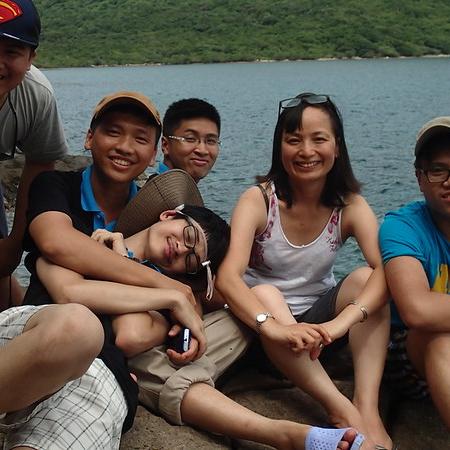
When Ha Do, a Vietnamese British housewife, received an invitation to join the volunteer sea turtle conservation programme in Con Dao National Park. Despite having many years working in biodiversity conservation in Vietnam before resettled in UK, Con Dao still brings Ha many interesting surprises. After a week of living with rangers in Hon Bay Canh, participating in sea cleaning and sea turtle rescue activities, Ha and her team truly immersed themselves in the lives of people who make every effort to maintain the largest nesting sea turtle populations in Vietnam.
Around Con Dao, Ha and other volunteers learned that sea turtles are still seriously threatened by human activities: including the risk of death from economic activities and the illegal hunting, and especially turtle eggs sold to restaurants. They appreciated the hard work of the park rangers and staff who are working hard every day to keep Con Dao as the most favourable home for sea turtles in Vietnam.
The marine turtle conservation programme in Con Dao began in the mid-1980s, when the Forbidden Forest of Con Dao was newly established. With initial groping, protected area staff sought to help protect and hatch the first batch of sea turtles and put on self-made tags to try to track the frequency of female sea turtles back to their breeding grounds. These efforts have since received the attention and support of international conservation organizations, especially WWF and IUCN. The park's scientific staff have been trained, and hatcheries that are more professional have been built in the breeding grounds. Every year, hundreds of sea turtles come to breed in Con Dao, tens of thousands of eggs are hatched in turtle lakes, and tens of thousands of baby turtles are released to the sea. Since the mid-2010s, the sea turtle volunteer programs have attracted hundreds of volunteers. This activity not only contributes human resources to the sea turtle conservation program but also serves as an inspiration for communication activities to raise awareness about sea turtle conservation. In particular, Six Senses Resort (Vietnam Resort Co., Ltd.) has recently cooperated with the National Park to invest in the construction and maintenance of sea turtles spawning grounds on Dat Doc beach. This is an important start to the socialization of resources for biodiversity conservation.
